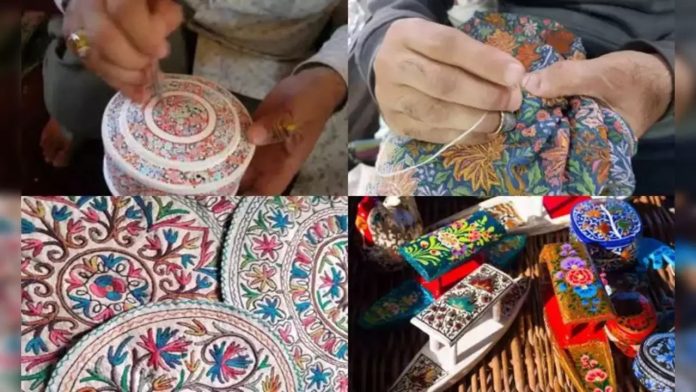Srinagar city getting World Craft Council recognition is ok, but the artisan community is in bad shape.
Street Talk
Expert Opinion

Srinagar has become the fourth Indian city to be recognized as a ‘World Craft City’ by the World Craft Council (WCC), following its designation as part of the UNESCO Creative City Network (UCCN) for crafts and folk arts three years ago.
The WCC recognition is considered an esteemed designation given to cities that excel in the promotion and development of traditional crafts and craftsmanship. This recognition acknowledges the city’s commitment to preserving and promoting its unique craft heritage and supporting local artisans.
The economic benefits by virtue of this designation includes a boost to the local economy by attracting tourists, investors, and buyers interested in authentic crafts, thereby increasing market opportunities for artisans. It also means cultural preservation, ensuring that these traditional craft practices are passed down to future generations.
The most important aspect of the recognition is the support for local artisans in terms of funding, training, and opportunities for international collaboration and exchange. In the context of this benefit, local Kashmiri craftsmen are not fortunate as this highly skilled community has been living in abject poverty and their plight lacks attention of authorities.
Let me deliberate upon the issue.
For the past few years, I have come across some stunning shades of life existing in our society. Even as these startling facts are open to a naked eye, our lack of attention has masked them behind the veil, which is silently consuming poor lives. Yes, I am talking about miseries of our artisan community. They have been hailed for making our handicrafts a prized possession worldwide, but nobody even has an idea that circumstances have forced these golden hands to surrender their welfare to the clutches of death.
I have some stunning tails to share in the context of the plight of our artisan community. By virtue of my organizational job profile in the bank, an old aged lady hailing from downtown Srinagar approached me with an application for financial assistance to undergo heart valve surgery. Her breathlessness was speaking for her ailment. On verification we learnt her husband was an artisan who was rendered handicapped after a severe heart stroke some years back. Prior to his ailment he was earning Rs.4,000 to Rs. 5,000 per month feeding his family of four members. After the ailment, his income had dropped to Rs.3,000 per month. Living in a dilapidated two room set, he would hardly see his two ends meet. Now with a squeezed domestic budget, the ailing artisan was left with no option but to ‘beg’ for financial support for treatment of his spouse. It took him more than a year to accumulate only half of the money required for treatment of his better-half. Her surgery was only possible when my organization paid the rest of the money to the hospital from its corporate social responsibility fund.
its still in my mind when, some time back, a paper machie artisan suffered brain stroke and his family virtually came on the roadside for want of financial support not only to seek financial assistance for treatment of their only bread-earner but also to have two-time meals.
It was astonishing to note that dozens of similar cases were reported from downtown Srinagar and other artisan cluster dominated areas. In all such cases, I observed that the education of their children became an immediate causality.
Over a period of time, the standard of living of our artisan community has not grown to a size which could have supported them in the event of need. It’s pertinent to mention here that lack of sufficient financial resources has always remained a hurdle in their growth and prosperity. Formal financial system is yet to understand their plight, resulting in their poverty. This plight has been there for centuries. In the name of financial support, the influential hijack the craft of the artisans for peanuts.
In olden days, exporters and middlemen used to fleece the artisans by giving them small loans and in exchange taking their crafts at a very marginal price. They used to sell these pieces of art to the outside world at lucrative prices. Thus there was a yearning gap between the people who used to produce it and those who used to sell it.
Today when we talk of modernizing the art and the artisan, the situation has not changed much. Artisans continue to be in a dilemma for lack of proper financial resources. We cannot end the chance of exploiting poor artisans by middle man, but at least we can reduce it.
Precisely, the point here is that our artisan community is now an endangered community. Today, it’s not the matter of survival of the arts and crafts of our state, but the growing miseries of our craftsmen which have been taxing them. Today most of such craftsmen are in the death kennel awaiting attention of society at large to come out of the miseries. Their skillful craftsmanship has captured the hearts of millions of people, but their own hearts are bleeding today. In the prevailing environment, their craftsmanship has failed them to even feed their families.
One more serious dimension of the poor condition of our artisan and craftsmen community is that it serves as a source of child labour. While in distress, they push their children into the trade.
There is a need for a coordinated approach by various government departments to ensure holistic development of artisans, as the welfare of artisans is directly associated with the welfare of the economic aspect of our region. Those associated with the protection and promotion of artisan communities at the grass root level should conduct a survey in artisan dominated clusters so that appropriate welfare measures are devised. At the moment, the education of their children should be supported by the government. If their today is miserable, proper education at this stage can power their prosperous future.
Last but not the least. Marketing strategy needs a focus to promote local crafts in the given situation where consumers are socially conscious, ethically and environmentally showing responsible behaviour. Investment in the research and design capacity of artisans also needs to be included in any strategy that seeks to address the marketing and market demand problems confronting artisans. Let assistance from professional designers to artisans is also facilitated to integrate new ideas and tradition. This would certainly lead to a new set of products and can ultimately be pivotal to saleability.
(The author is a veteran journalist/columnist. He is former Head of Corporate Communication & CSR and Internal Communication & Knowledge Management Departments of J&K Bank)


